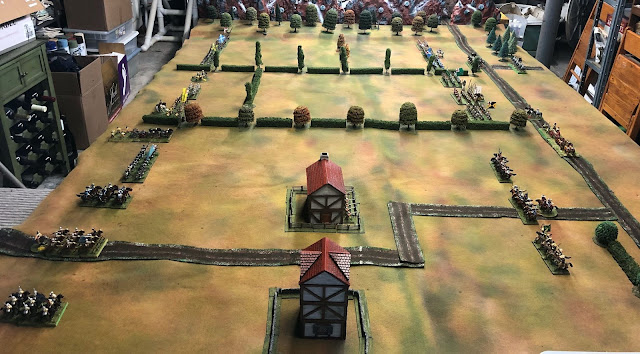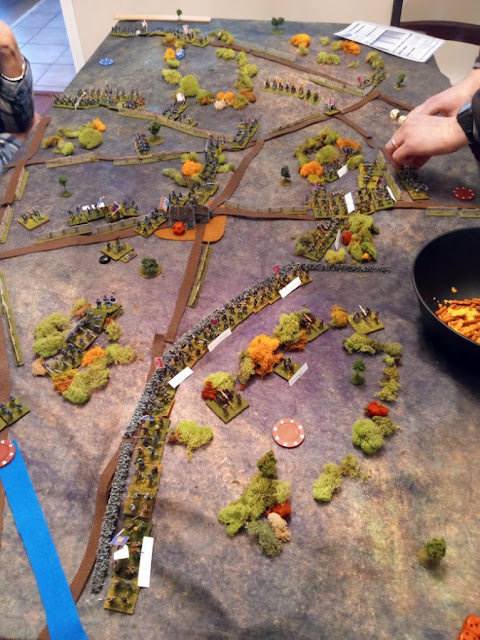On Saturday, Thomas, Nick and I got together for a game at Jared's home on short notice; he already had another game set up in the basement, and his wife was out for the day, so we played on the dining room table!
The scenario was 2nd Manassas (Bull Run), and the rules were Big Bloody Battles by Chris Pringle. Jared had run games with the rules, and I had a copy which I had skimmed a bit, but none of us had ever actually played the rules before!
We diced for sides, and that left Jared and me with the boys in blue, and Thomas and Nick with the Rebs. The Confederates started with just Stonewall Jackson's command on the table, but well situated on hill with rifle pits at its base.
Thomas and Jared deployed well, with their 3 batteries being exceptionally well positioned on the hilltop.
Close up of the troops on Jackson's right. The figures are from Jared's excellent 15mm ACW collection; he says they hadn't been out on the gaming table for at least 10 years
J.E.B Stuart's cavalry were the only troops protecting one of the three Confederate objectives... at least to start. We both knew the other side had reinforcements coming on, but not when or where! The game is wonby taking at ,least 2 of the three enemy positions while holding at least 2 of your own.
Part of the Union deployment.
The rest of the Union deployment.
Situation after the first Union move; one of our Divisions is moving to seize control of the Bridge over Bull Run and its associated Objective; unfortunately, much of these troops are Raw and thus rather brittle.
Although we had troops that could have entered on Turn 1, they flubbed their roll and failed to appear. Longstreet's boys showed up nice and promptly for the Secessionists!
On Union Move 2, the bridge is taken with no losses...
because the men in grey have focused all their fire on two of the Union batteries, silencing one; it will have to withdraw to the rear next move, then move up on the following move, before it will be able to fire offensively again! In these rules, "opportunity" fire can be taken during your opponents move at any troops that moved or changed formation. With most of the infantry armed with rifled muskets (range 9"), and the artillery having an 18" range, this can be a real nuisance!
Fire by Johnny Reb's guns have silenced a second Union battery on turn 2!
Still, we Yanks control one Rebel objective; unfortunately, taking a second is not seeming very likely!
Longstreet's men deploy in preparation for an attack on our not very strong center, and our own reinforcement finally arrive! Stuarts cavalry use the swift road movement (troops move TWICE as far on roads, something the author conveniently left off the QRS; what is it about authors and their rules summary sheets? You'd think such a huge factor belongs on it, wouldn't you?!)
Another view of the overall situation at this point.
Another view of the same.
Our reinforcements advance, much faster than their first attempt, now that we know about the huge road move bonus! Not the blue chip denoting an objective way out here!
One of Longstreet's Brigades advances boldly upon our center. Our defensive fire? "They couldn't hit an Elephant!"
The consequences of their ineffectual fire was an assault by the aggressive Rebs, whose own closing fire disrupted our brave boys.
In the event, the assault was narrowly repulsed.
Our reinforcements move up, while Stuart's cavalry attempt an outflanking move!
Overview of the action, Stuart's cavalry having redeployed to their right.
Stuart's cavalry charge, the boys in blue once again failing to have any impact with their defensive fire. Grr! At least the Confederate infantry behind them, which was planning to support the attack, rolled a half move and lacked sufficient legs to join the fight!
First and ten, do it again; Rebs from the Palmetto state, having shaken off their disruption, charge again. Had I realized it, if the unit behind them been in contact with the unit to their front, this would have given positive melee modifiers for depth and numbers. This time the Yanks are pushed back, and both units are disrupted.
Quite mess on the Union far left; bringing our superior numbers to bear has proved very challenging!
Judging the time right, Jackson's infantry move of their defensive positions, and move to the attack!
Close up of Jackson's advance - veteran troops supported by artillery, and facing off against Raw; this will go well... not!
Their supports, our sole Veteran brigade, get shot up by rifle and artillery fire, losing a base and becoming disrupted. Ugh!
Longstreet (played by Nick) continues his aggressive push up the center; this time the attacking unit is supported by a second unit in Depth behind them; this gives positive modifiers for Depth and 2:1 outnumbering. Yuck! Not surprisingly, this time my Yanks are forced back 9" with disruption and the loss of a base.
This allows the victorious Rebels to make a breakthrough move and continue to attack! Now worries, 2 batteries of artillery firing at cannister range should rip them to shreds! Eh, what's that? NO defensive fire at breakthrough charges? Hellfire and damnation! Who wrote these rules? :-)
My batteries rolled very well to escape with "retreat 3 inches, silenced! At least only ONE breakthrough assault is allowed per unit per turn. Phew!
Final charge of the game, Confederate infantry supported by their cavalry, charge Jared's infantry. Once again, they fail to hit anything, while the Rebs fire achieves a disruption. Yeah, they're gonna win that one - NOT! At this point, it was the end of Turn 5; mercifully, for the Union cause, night fell and the fighting died off.
The photos are a combination of mine and those by Thomas. He had a number of funny quips following the game:
"Thomas just about polished off all the chips. Thank God he missed the poker ships on the table!"
"Gotta prep for Church tomorrow, Nick!"
Jared says "Let's see... if I order pizza I bet I can get Peter to start liking this period. I'm gonna try!"
.JPG)
Peter says "Nice try, Jared (though the pizza was delish), but no, that's not for me! Not enough color on these troopers, and where is combined arms warfare? dragoons who can't even follow through on a decent saber attack?!"
In truth I had a great time, with great guys! Learning a new set of rules is always an experience. I prefer Field of Battle/Battle Command, but I'd play these rules again, too!










.JPG)
.JPG)



.JPG)
.JPG)

.JPG)


.JPG)
.JPG)


.JPG)



.JPG)

.JPG)




.JPG)
.JPG)

.JPG)


.JPG)
.JPG)

.JPG)




